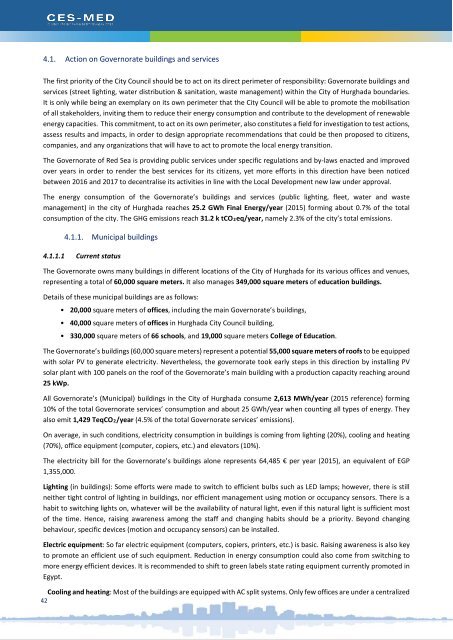020318_Hurghada SECAP_FINAL
You also want an ePaper? Increase the reach of your titles
YUMPU automatically turns print PDFs into web optimized ePapers that Google loves.
4.1. Action on Governorate buildings and services<br />
The first priority of the City Council should be to act on its direct perimeter of responsibility: Governorate buildings and<br />
services (street lighting, water distribution & sanitation, waste management) within the City of <strong>Hurghada</strong> boundaries.<br />
It is only while being an exemplary on its own perimeter that the City Council will be able to promote the mobilisation<br />
of all stakeholders, inviting them to reduce their energy consumption and contribute to the development of renewable<br />
energy capacities. This commitment, to act on its own perimeter, also constitutes a field for investigation to test actions,<br />
assess results and impacts, in order to design appropriate recommendations that could be then proposed to citizens,<br />
companies, and any organizations that will have to act to promote the local energy transition.<br />
The Governorate of Red Sea is providing public services under specific regulations and by-laws enacted and improved<br />
over years in order to render the best services for its citizens, yet more efforts in this direction have been noticed<br />
between 2016 and 2017 to decentralise its activities in line with the Local Development new law under approval.<br />
The energy consumption of the Governorate’s buildings and services (public lighting, fleet, water and waste<br />
management) in the city of <strong>Hurghada</strong> reaches 25.2 GWh Final Energy/year (2015) forming about 0.7% of the total<br />
consumption of the city. The GHG emissions reach 31.2 k tCO2eq/year, namely 2.3% of the city’s total emissions.<br />
4.1.1. Municipal buildings<br />
4.1.1.1 Current status<br />
The Governorate owns many buildings in different locations of the City of <strong>Hurghada</strong> for its various offices and venues,<br />
representing a total of 60,000 square meters. It also manages 349,000 square meters of education buildings.<br />
Details of these municipal buildings are as follows:<br />
• 20,000 square meters of offices, including the main Governorate’s buildings,<br />
• 40,000 square meters of offices in <strong>Hurghada</strong> City Council building,<br />
• 330,000 square meters of 66 schools, and 19,000 square meters College of Education.<br />
The Governorate’s buildings (60,000 square meters) represent a potential 55,000 square meters of roofs to be equipped<br />
with solar PV to generate electricity. Nevertheless, the governorate took early steps in this direction by installing PV<br />
solar plant with 100 panels on the roof of the Governorate’s main building with a production capacity reaching around<br />
25 kWp.<br />
All Governorate’s (Municipal) buildings in the City of <strong>Hurghada</strong> consume 2,613 MWh/year (2015 reference) forming<br />
10% of the total Governorate services’ consumption and about 25 GWh/year when counting all types of energy. They<br />
also emit 1,429 TeqCO2/year (4.5% of the total Governorate services’ emissions).<br />
On average, in such conditions, electricity consumption in buildings is coming from lighting (20%), cooling and heating<br />
(70%), office equipment (computer, copiers, etc.) and elevators (10%).<br />
The electricity bill for the Governorate’s buildings alone represents 64,485 € per year (2015), an equivalent of EGP<br />
1,355,000.<br />
Lighting (in buildings): Some efforts were made to switch to efficient bulbs such as LED lamps; however, there is still<br />
neither tight control of lighting in buildings, nor efficient management using motion or occupancy sensors. There is a<br />
habit to switching lights on, whatever will be the availability of natural light, even if this natural light is sufficient most<br />
of the time. Hence, raising awareness among the staff and changing habits should be a priority. Beyond changing<br />
behaviour, specific devices (motion and occupancy sensors) can be installed.<br />
Electric equipment: So far electric equipment (computers, copiers, printers, etc.) is basic. Raising awareness is also key<br />
to promote an efficient use of such equipment. Reduction in energy consumption could also come from switching to<br />
more energy efficient devices. It is recommended to shift to green labels state rating equipment currently promoted in<br />
Egypt.<br />
Cooling and heating: Most of the buildings are equipped with AC split systems. Only few offices are under a centralized<br />
42

















